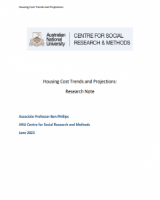Housing Cost Trends and Projections: Research Note

Abstract
Housing costs are for many households a very significant share of their regular expenditure. Those with a mortgage pay both interest and usually slowly pay off the principal of their house value. Those who rent pay a regular amount to a landlord. Interest rates have increased significantly over the past 12 months and advertised rents have also increased dramatically. Actual rents, as measured by the ABS Consumer Price Index for capital cities, have also increased but not to the same extent as advertised rents (ABS 2023). This research note considers how housing costs have changed for households relative to their income over the past four decades, and in particular, how the most recent changes in rents and mortgage rates impact households for different income levels.
Using the ANU model of tax and transfers, PolicyMod, disposable income can be estimated for households across the income distribution taking into account recent changes in government policy (such as the recent increase in rent assistance and JobSeeker payments) and also important changes in the labour market such as lower unemployment rates and higher employment rates. The model also takes into account changes in average rents and mortgage interest and principal repayments. Combining all these changes provides useful insights into which groups recent changes in the housing market are most likely to impact. Is it higher income or lower income households, renters or mortgagors who are impacted the most?
This research combines ABS income surveys since 1984 to consider how housing costs have altered up to 2019. Beyond 2019 PolicyMod (also based on income survey data) provides estimates and projections of how housing costs and incomes have changed for households up to 2023 (December).








